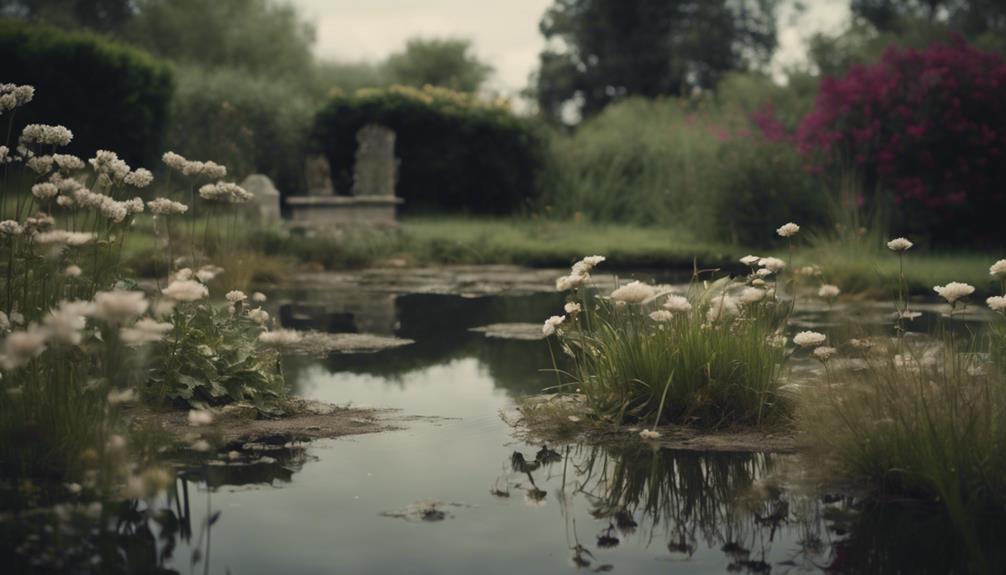You've invested time and resources into creating a serene pond oasis in your backyard, so why settle for bland, uninspired edging that fails to elevate its beauty and functionality? A well-executed pond edge adds elegance, maintains ecological harmony, and supports local wildlife. It also prevents accidental slips, contains plants, and controls erosion. With numerous material options, design styles, and maintenance requirements to ponder, ordinary pond edging ideas simply won't cut it. By exploring the world of pond edging, you'll discover innovative solutions that transform your pond into a breathtaking visual masterpiece, and reveal its full potential as a stunning outdoor space.
Table of Contents
Key Takeaways
- Ordinary pond edging ideas can elevate your garden's visual appeal and create a thriving ecosystem that is both aesthetically pleasing and environmentally responsible.
- A well-executed pond edge adds elegance, prevents erosion, and supports local wildlife, making it a crucial aspect of pond design and maintenance.
- Unique and thoughtful edging designs can reflect personal style, complement the outdoor space, and create a beautiful, functional, and sustainable water feature.
- Pond edging materials like rocks, natural stones, and plants offer durability, environmental support, and aesthetic benefits, making them worth considering for your pond.
- Proper pond edging maintenance is essential for a safe, sustainable, and visually appealing water feature that supports local biodiversity and ecosystem harmony.
Understanding Pond Edging Basics
As you set out on designing or renovating your pond, it's imperative to grasp the fundamental principles of pond edging, a pivotal aspect that not only enhances the visual appeal of your water feature but also serves as a functional barrier between the pond and its surroundings.
A well-executed pond edge not only adds a touch of elegance to your garden but also plays a pivotal role in maintaining the ecological harmony of your backyard habitat.
By understanding the basics of pond edging, you'll be able to create a thriving ecosystem that's both aesthetically pleasing and environmentally responsible.
When it comes to pond edging ideas, it's necessary to examine the functional aspects as well.
Edging helps contain plants, preventing them from falling into the water, and contributes to erosion control, especially in areas prone to heavy rainfall or sloping terrain.
Additionally, a well-edged pond supports local wildlife and prevents accidental slips or falls, making it a key aspect of pond maintenance.
Types of Pond Edging Materials
When designing your pond's edge, you're spoiled for choice with various materials that can transform your water feature into a stunning focal point, from rugged rocks and natural stones to plant-based edging and raised borders.
To help you decide, here's a breakdown of some popular pond edging materials:
| Material | Description | Benefits |
|---|---|---|
| Rocks and Natural Stones | Rugged, natural look | Durable, long-lasting, and visually appealing |
| Plant-Based Edging | Integrates plants into the pond's edge | Beautifies the area, supports local ecosystem |
| Raised Edging | Adds visual appeal, prevents soil erosion | Defines the pond's boundary, easy maintenance |
| Wildlife-Friendly Options | Attracts and supports native species | Creates a harmonious environment, biodiversity |
Each material offers unique benefits, from durability to environmental support. Rocks Around, for instance, can create a stunning, natural-looking pond edge. Consider your pond's style, ecosystem, and maintenance needs when choosing the perfect material for your pond edges. By selecting the right material, you'll create a beautiful, thriving water feature that becomes the heart of your outdoor space.
Creative Pond Edging Ideas
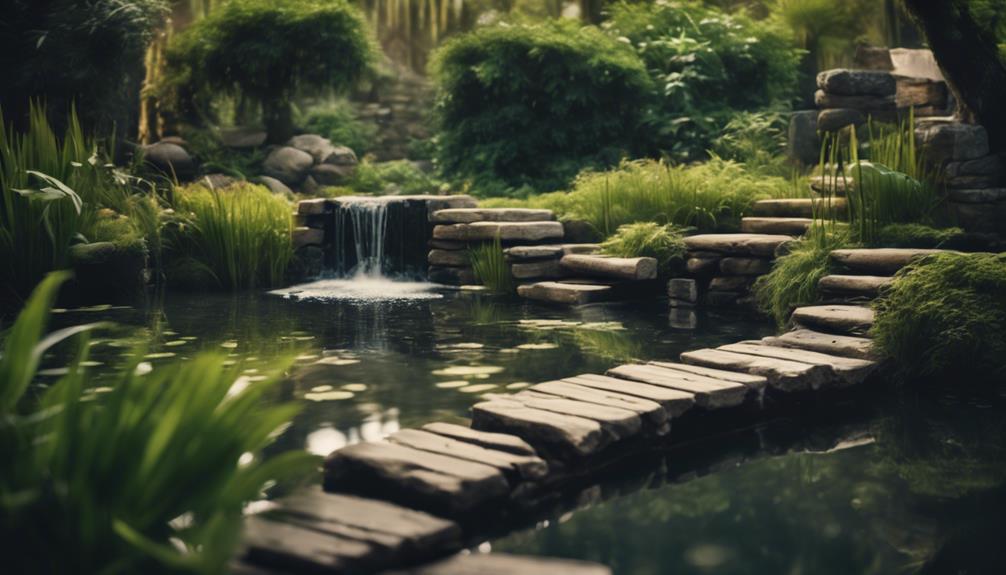
Now that you've chosen your pond edging material, it's time to get creative with your design, incorporating unique elements that reflect your personal style and complement your outdoor space.
Consider adding a layered rock edge around the pond, which not only stabilizes the bank but also creates a natural, multi-dimensional look. You can combine this with other materials, like pebbles or plants, to add visual interest and create a unique design.
If you want to attract native species, opt for a wildlife-friendly design featuring shallow, sloping sides and a combination of pebbles and plants. This won't only support local biodiversity but also create a beautiful, natural-looking ponds edge.
Alternatively, you can incorporate raised edging to add visual appeal and help with pond maintenance. This can be combined with plants or pebbles to create a textured, interesting look.
Whatever design you choose, remember to have fun and get creative – after all, your pond's edge should reflect your personal style and complement your outdoor space.
Importance of Pond Edging Maintenance
As you focus on creating a beautiful and functional pond, you'll want to prioritize pond edging maintenance to guarantee your water feature remains safe, sustainable, and visually appealing.
By doing so, you'll avoid common issues like erosion, sedimentation, and safety hazards, while also enhancing the overall aesthetic of your pond.
In the following sections, we'll explore the essential aspects of pond edging maintenance, including edging for safety, preventing erosion, and more.
Pond Edging Essentials
By investing time and effort into pond edging maintenance, you're taking a pivotal step in safeguarding your pond's ecosystem, preventing erosion, and securing a safe and beautiful backyard habitat.
A well-maintained pond edging is essential for the overall health and aesthetics of your garden pond. It prevents plants from falling into the water, making maintenance easier, and creates a barrier between the water and surrounding land.
This barrier is necessary for erosion control, especially if your pond is located on a slope or near heavy rainfall areas. Regular maintenance guarantees the longevity of your pond and its surroundings, preventing safety hazards, environmental issues, and decreased property value.
Edging for Safety
When it comes to ensuring a safe and enjoyable outdoor space, proper pond edging maintenance takes center stage, providing a pivotal barrier between the water and surrounding land.
As you consider your pond edging design, remember that safety should be your top priority. You want to create an environment where everyone, including children, pets, and elderly individuals, can enjoy the beauty of your pond without worrying about accidents.
Three key reasons why edging for safety is essential:
- Prevents accidents: A well-maintained edge prevents slips and falls into the pond, ensuring a safe and enjoyable experience for everyone around the edge.
- Contains plants: Proper edging keeps plants from falling into the water, making it easier to maintain the pond's ecosystem and aesthetic appeal.
- Supports ecological balance: A well-edged pond contributes to the ecological balance and health of your backyard habitat, supporting local wildlife and creating a thriving ecosystem.
Preventing Erosion
Proper pond edging maintenance serves as a bulwark against the erosive forces that can wreak havoc on your backyard oasis, threatening to undo the beauty and tranquility you've worked so hard to create.
You've invested time and effort into building a serene escape, and neglecting edge maintenance can lead to costly repairs, water loss, and habitat disruption for aquatic life.
Erosion can occur due to water flow, rainfall, or human activity, making regular inspections and maintenance essential to prevent damage.
By using edge materials like rocks, gravel, and plants, you can stabilize the soil and prevent erosion. However, these materials require regular upkeep to guarantee effectiveness.
Neglecting maintenance can lead to safety hazards, such as slippery or uneven surfaces, and compromise the overall aesthetic and ecological value of your pond.
By prioritizing edge maintenance, you can prevent soil and sediment from entering the water, reducing the risk of algae blooms and water quality issues.
Take control of your pond's edge using materials that work for you, and enjoy the peaceful retreat you deserve.
Overcoming Pond Edging Challenges
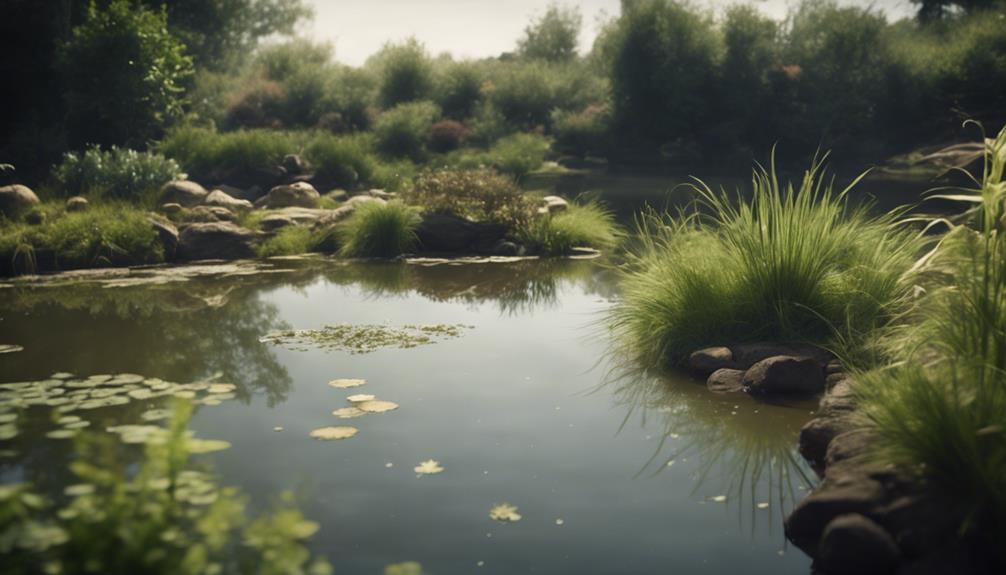
As you set out on designing your pond's edge, you'll inevitably encounter a range of challenges that can make or break the entire project, but with the right strategies, you can overcome them.
One of the biggest hurdles is dealing with the water line, where the pond meets the surrounding landscape. You'll need to address issues like uneven terrain, water flow, and drainage.
To overcome these challenges, consider the following strategies:
Terrain troubles: Use a combination of rocks, plants, and creative design elements to create a visually appealing and functional pond edge.
Water woes: Incorporate features like gutters and French drains to prevent runoff into the pond and guarantee proper water circulation.
Erosion control: Use erosion-control fabrics, plant sturdy vegetation around the edges, and build the pond above grade to reduce the risk of a floating liner.
Designing a Wildlife-Friendly Pond
By incorporating natural elements and thoughtful design choices, you can create a pond edge that not only overcomes the challenges of uneven terrain and water flow but also becomes a thriving habitat for local wildlife.
A well-designed wildlife pond can attract a variety of species, including frogs, toads, newts, and birds, and provide a thriving ecosystem.
To achieve this, incorporate rocks, gravel, and plants around the pond edge to create a natural-looking habitat that encourages wildlife to visit and inhabit the area.
Consider using a combination of shallow and deep areas, as well as incorporating features like log piles and rock piles, to create a diverse range of habitats for different species.
Edging the pond with plants like marsh marigold, water mint, and bog cotton can provide shelter and food for visiting wildlife, while also helping to maintain water quality.
Pond Edging for Aesthetics and Function
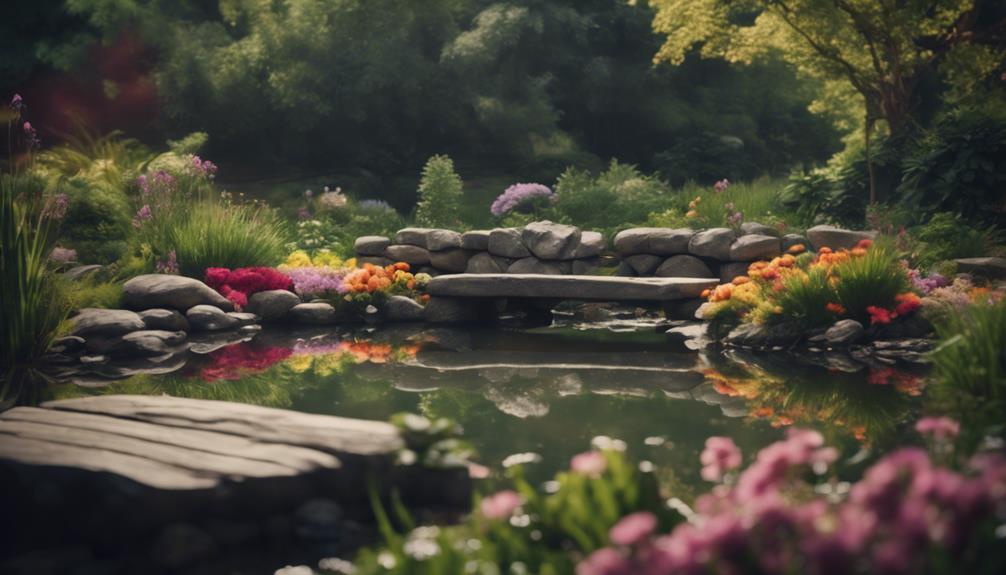
As you consider pond edging for aesthetics and function, you'll want to focus on the essential elements that make a pond visually appealing and safe to maintain.
You'll need to balance form and function by selecting edging materials that complement your pond's surroundings while also preventing erosion and slips.
Pond Edging Essentials
When designing your pond's edging, you must prioritize both aesthetics and function to create a visually appealing and watertight environment.
To achieve this, vital consideration must be given to the pond edging essentials.
Pond Edging Essentials Checklist:
- Verify a secure seal: The pond liner should overlap the edge by at least 3-6 inches to prevent water from seeping behind the edging.
- Safeguard the liner: The liner shouldn't shrink over time if installed correctly, and a waterproof edging method can be used to cover the liner.
- Conceal the liner: Planting soil right up to the edge or laying rocks on top can hide the liner, but proper installation and edging techniques are vital to verify a secure and leak-free pond.
Natural Stone Options
Transform your pond's perimeter into a stunning focal point by incorporating natural stone options that seamlessly blend aesthetics and function. You'll not only enhance the beauty of your pond but also create a functional barrier between the water and surrounding land.
Rocks and natural stones are durable and long-lasting, making them an excellent choice for pond edging. They can withstand harsh weather conditions and heavy foot traffic, ensuring your pond's perimeter remains secure and visually appealing.
A well-designed natural stone edging can also help prevent erosion, contain plants, and create a visually appealing shift between the pond and surrounding landscape.
The type of natural stone you choose can greatly impact the overall look and feel of your pond, with options ranging from rustic fieldstone to sleek bluestone.
Furthermore, natural stone edging can help create a thriving ecosystem by providing habitat for wildlife and supporting local biodiversity. By incorporating natural stone options, you'll create a pond that's not only stunning but also functional and eco-friendly.
Essential Pond Edging Considerations
Before you start selecting materials and designing your pond's edge, consider the essential factors that will guarantee a stable, functional, and environmentally responsible water feature. You want to certify your pond's water level remains consistent and doesn't compromise the surrounding environment.
Three vital considerations to keep in mind:
- Elevation and overlap: The pond edge should be higher than the surrounding ground to prevent runoff and certify a stable water level. Additionally, the liner should overlap the edge by at least 3-6 inches to prevent water from seeping behind the edging.
- Liner installation: Fill the liner to the top, tucking the extra liner inside the block and filling it with soil, leaving about 2 inches of exposed liner.
- Material selection: Choose edging materials that align with your personal preferences, functional needs, and environmental concerns.
Innovative Pond Edging Solutions
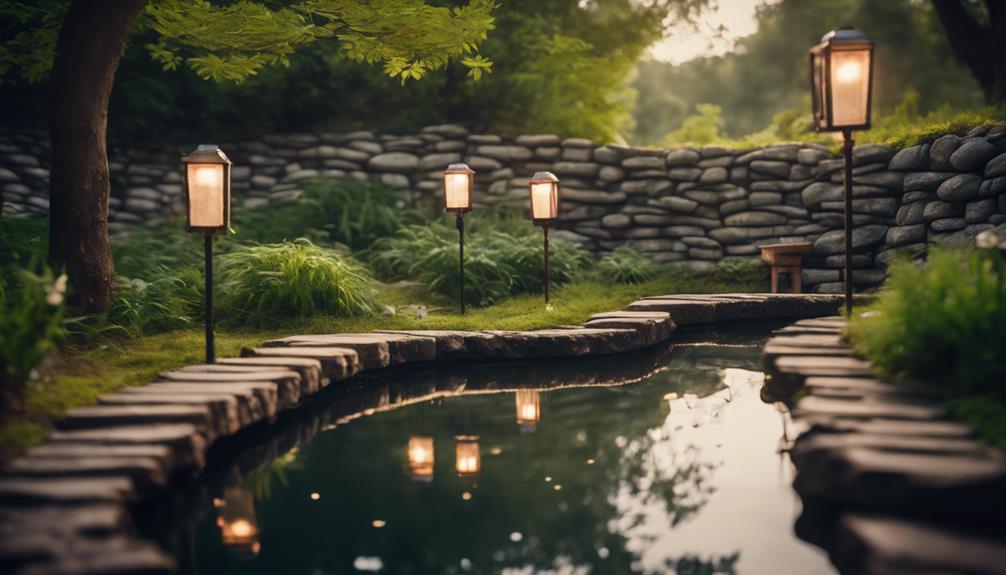
As you explore innovative pond edging solutions, consider combining function and aesthetics to create a visually stunning and functional water feature that reflects your personal style.
Rocks and natural stones create a rugged, natural look and are durable and long-lasting, making them a popular choice.
Alternatively, plant-based edging integrates plants into the pond's edge, beautifying the area and supporting the local ecosystem.
Raised edging adds visual appeal and helps with pond maintenance by preventing soil erosion and offering a defined boundary.
You can also incorporate practical elements like steps or seating areas into the pond edging, allowing for a themed edging that reflects a specific style.
For a truly unique look, consider adding solar-powered lights to highlight the edging design and create ambiance.
By combining these innovative solutions, you can transform your pond into a breathtaking water feature that becomes the centerpiece of your outdoor space.
With seating areas and clever design, you'll be tempted to linger by the water's edge, enjoying the serenity and beauty of your backyard oasis.
Transforming Your Pond With Edging
As you begin transforming your pond with edging, you'll notice a significant boost to its aesthetic appeal.
With a variety of design options at your fingertips, you can create a unique look that complements your outdoor space.
Pond Aesthetics Enhanced
By incorporating thoughtful edging designs, you can transform your pond into a stunning visual masterpiece that seamlessly blends with its surroundings. A well-edged pond not only enhances its aesthetics but also contributes to the ecological balance and health of your backyard habitat.
Edging elevates your pond's visuals in three ways:
Natural Blending: Edging helps create a natural barrier between the water and surrounding land, making your pond appear more visually appealing and organic.
Plant Containment: By containing plants, edging prevents them from falling into the water, reducing maintenance and the risk of aquatic plant overgrowth, while also showcasing your plants in a beautiful, intentional way.
Erosion Prevention: Edging prevents erosion, especially on slopes or in heavy rainfall areas, ensuring your pond remains a thriving ecosystem.
Edging Design Options
You can discover a world of creative possibilities for your pond's edge by exploring the various edging design options that not only enhance its visual appeal but also serve a functional purpose.
Rocks and natural stones create a rugged, natural look that's durable and long-lasting.
Alternatively, plant-based edging integrates plants into the pond's edge, supporting the local ecosystem and attracting native species.
Raised edging adds visual appeal while preventing soil erosion and offering a defined boundary.
You can also combine function with aesthetics by incorporating practical elements like steps or seating areas into the pond edging.
Themed edging can tailor the pond's edge to reflect a specific theme, such as a Zen garden or rustic look.
Finally, lighting can transform your pond into a stunning feature at night, with solar-powered lights being an eco-friendly option that highlights the edging design and creates a dramatic ambiance.
Frequently Asked Questions
What to Put Around the Edge of a Pond?
When deciding what to put around the edge of your pond, you're considering a vital aspect of your water features' overall aesthetic. You'll love the rustic charm of decorative rocks, which complement your pond's natural beauty while adding functional appeal.
How Do You Finish the Edges of a Pond?
As you finish the edges of your pond, you'll want to guarantee a seamless blend of water and land. You're skimming the surface of pond perfection by overlapping the liner, hiding it with rocks and soil, and creating a natural-looking edge that blends water and surroundings.
How to Hide Pond Liner Edges?
You craftily conceal the liner's curves with clever camouflage, employing silky soil slopes, rippling rock layers, and waterproof wizardry to weave a seamless edge, masterfully merging the liner with its surroundings.
How Do I Soften the Edges of My Pond?
You soften the edges of your pond by incorporating pond planting, like trailing lobelia or creeping Jenny, which add color and shade for pond life, and consider water features like rocks or natural stones for a natural, rugged look.
Conclusion
As you wade through the world of pond edging, remember to flaunt your flair for fusion, where form meets function in flawless harmony.
By fusing fancy features with functional fixes, you'll forge a fascinating facade that frames your pond perfectly.
Fearless experimentation with fresh ideas and forward-thinking materials will fuel your journey to a fantastically edged oasis that's as functional as it's fabulous.

